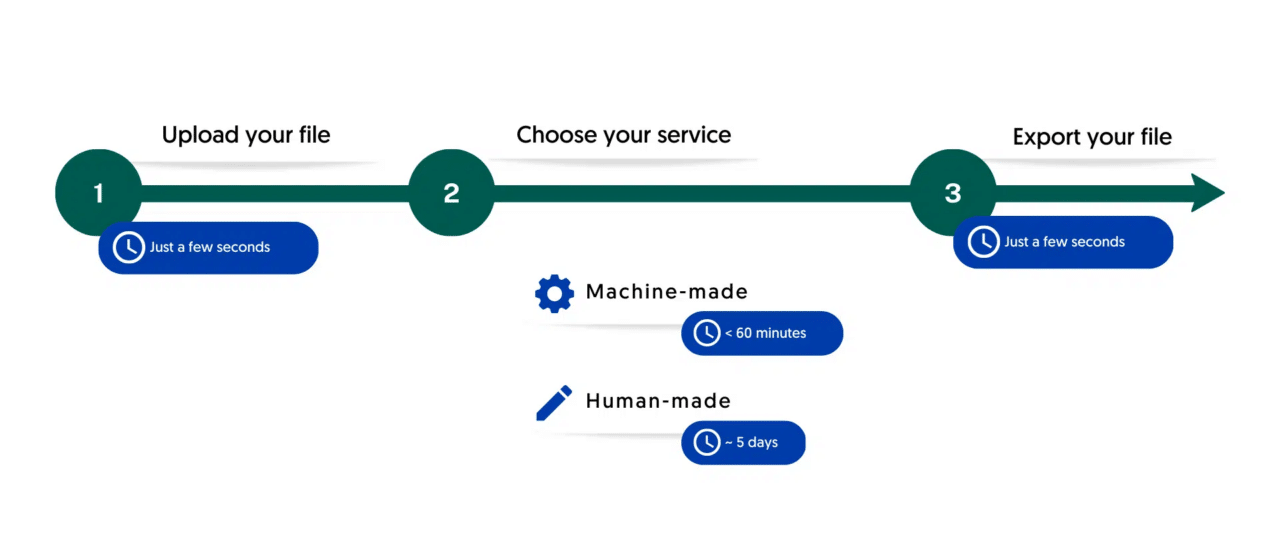Whether you are in the legal, medical, or media industry, accurate and precise transcripts serve as the backbone for communication, reference, and analysis. In this comprehensive guide, we unveil ten invaluable tips that will elevate your transcription prowess to new heights. From equipping yourself with the finest tools to outsourcing transcription services, these strategies will empower you to craft transcripts of unparalleled quality.
Table of Contents
10 Tips for Perfect Transcripts
1. Quality Equipment and Environment
To ensure accurate and precise transcripts, it’s imperative to have quality equipment and a noise-free environment. A good microphone is indispensable for capturing distortion-free audio, and we recommend using a digital recorder or an external microphone over a device’s built-in mic. Additionally, using headphones can improve audio quality by eliminating external noise.
Recording in a quiet environment is equally crucial. Background noise can disrupt audio and hinder accurate transcription. Choosing a closed room with minimal distractions and informing others about the recording session to avoid interruptions can make a significant difference in audio quality. By investing in quality equipment and creating an ideal recording environment, you lay the foundation for high-quality audio and improved transcription accuracy.

How to improve audio quality?
Read the blog2. Professional Transcription Software or Services
Transcription software and services offer convenient and efficient solutions for transcribing audio or video recordings. There are various options available, including automated transcription tools and professional human transcription services. These tools leverage advanced technology for transcription, offering features like speaker identification and time-stamping, streamlining the transcription process.
Selecting the right transcription software or service depends on your specific needs and budget. For simple audio recordings, automated tools may suffice, but for complex or lengthy transcripts, professional transcription services are advisable. They provide expert transcribers capable of handling challenging accents, technical terminology, and multiple speakers. Additionally, they offer options for verbatim or clean transcripts, catering to your preferences. Utilizing professional transcription software or services not only saves time but also ensures high-quality transcripts.
3. Use Timestamps
Timestamps are essential for quick and accurate reference in transcripts. They facilitate navigation through lengthy recordings, allowing you to locate specific information without the need to listen to the entire recording again. Timestamps can be added manually at regular intervals or automatically using transcription tools.
To determine the appropriate timestamp interval, consider the recording’s length and content. For shorter recordings, a timestamp every minute may suffice, while longer recordings with multiple speakers may benefit from timestamps at speaker changes or every few minutes. Ensuring timestamp accuracy and alignment with the recording device’s time is crucial. Timestamps save time and enhance the transcript’s accessibility for improved comprehension and analysis.
4. Transcription Style Guide
A transcription style guide is a set of rules governing transcript formatting, punctuation, and other aspects. It serves as a reference for transcribers to maintain consistency in their work. This guide should include instructions for speaker identification, timestamps, the use of abbreviations or acronyms, and specific formatting or punctuation requirements.
Consistency is pivotal in transcription, ensuring transcript accuracy and readability. By adhering to a style guide, transcribers produce consistent transcripts that are easier to understand and analyze. It also upholds professional standards, especially when transcripts have official or legal implications. Creating a personalized style guide or utilizing industry-standard guides like the AP Stylebook significantly improves transcript quality and precision.
5. Proofreading and Editing
Proofreading and editing are vital steps in the transcription process, ensuring the transcript’s accuracy and quality. Careful review for errors or discrepancies is necessary before finalizing the transcript. Common errors include misspellings, punctuation mistakes, and inaccurate timestamps. Consistency in formatting, such as maintaining uniform fonts and spacing throughout, is equally important.
To guarantee proper grammar, punctuation, and formatting, employ various proofreading techniques. Reading the transcript aloud helps identify errors missed while reading silently. Checking for homophones and using grammar checking tools like Grammarly or Hemingway enhances accuracy. Furthermore, having a second person review and edit the transcript can catch overlooked errors. While these steps may extend the transcription process, they are essential in achieving perfect and precise transcripts.
6. Speaker Identification
Clear and consistent speaker identification is essential for accurate transcripts. It enables readers to discern speakers throughout the transcript, facilitating comprehension of conversations or discussions. In multi-speaker recordings, proper speaker identification becomes especially critical, as visual cues are absent.
To identify speakers in multi-speaker recordings, transcriptionists can employ various methods, such as using initials or numbers to label speakers. Noting background noise or speech characteristics unique to each speaker can be helpful. Additionally, transcription tools can automatically identify and label speakers based on their voices, saving time and ensuring accuracy.
Precise and consistent speaker identification enhances transcript readability and understanding. Following these tips and using transcription tools aids in accurately identifying speakers in recordings with multiple participants, resulting in high-quality transcripts.
7. Verbatim vs. Clean Transcripts
Verbatim and clean transcripts represent two distinct transcription styles. Verbatim transcripts aim to capture every word, including filler words like “um” or “uh,” and nonverbal expressions such as laughter or pauses. In contrast, clean transcripts aim for a polished version of the conversation by omitting fillers and nonverbal expressions, enhancing overall readability.

What does Verbatim mean?
Learn moreChoosing between verbatim and clean transcripts hinges on the transcript’s intended purpose. Verbatim transcripts are suitable for legal or research contexts where documenting every word is crucial. Clean transcripts, conversely, are more appropriate for business meetings or interviews where readability is a priority. Clarity on the type of transcript needed is essential before commencing transcription to ensure efficiency and accuracy.
Consider these examples of verbatim and clean transcription excerpts from the same recording:
Verbatim: “Um, I don’t know. I guess, uh, we can try that option? Or maybe not.”
Clean: “I’m unsure. Let’s consider trying that option, or perhaps not.”
As evident from the examples, verbatim transcripts capture every spoken word, including fillers and nonverbal expressions, while clean transcripts present a more concise and polished conversation summary.
Both verbatim and clean transcripts have their advantages and are suitable for different purposes. Understanding these transcription styles’ distinctions and selecting the appropriate one for the transcript’s intended use is paramount. Ultimately, the goal is to create high-quality, accurate transcripts that serve their purpose effectively.
8. Transcript Storage and Retrieval
Organized transcript storage is essential for efficient transcription workflows. It allows for easy access and retrieval of transcripts, saving time and effort. Moreover, organized storage safeguards against transcript loss or misplacement, particularly when transcripts are needed for future reference.
To establish organized transcript storage, implement a consistent naming system for files, incorporating details like dates, speaker names, or topics. Utilize separate folders for various transcript types, such as interviews or conference calls. When retrieving transcripts, a well-organized storage system facilitates quick searches. Keywords or tags in naming conventions can further expedite the search process. Maintaining a record of the transcription progress, including completed and pending files, minimizes duplication and confusion.
Organized transcript storage streamlines transcription workflows. A systematic naming convention and distinct folders enhance transcript retrieval efficiency, saving time and effort. This ensures that essential transcripts are readily accessible for future reference, promoting a smooth transcription process.
9. Transcription Service Amberscript
Outsourcing transcription services can be advantageous, particularly for complex or lengthy transcripts, allowing individuals or companies to focus on other critical tasks. One such reputable and dependable transcription service provider is Amberscript.

Professional transcription services offer several benefits, including accuracy, speed, and convenience. Skilled transcribers possess expertise in transcribing diverse audio types, guaranteeing precise and high-quality transcripts, crucial for legal or research contexts.
Machine-Made Transcription: Amberscript’s Machine-Made Transcription service transforms spoken content into accurate written text swiftly and efficiently. With the ability to handle diverse audio qualities and accents, this technology underpins the subtitling process, laying the foundation for accurate and reliable subtitles.
Human-Made Transcription: Amberscript’s human-made transcription service is a testament to precision and expertise. Skilled transcribers excel in transcribing complex audio content, ensuring unparalleled accuracy. With rapid turnaround times and a focus on confidentiality, Amberscript’s human-made transcription service stands as a reliable partner for those seeking top-tier transcription solutions.
Outsourcing transcription services proves beneficial in situations where accuracy and efficiency are paramount. Choosing a professional transcription service provider such as Amberscript saves time and ensures high-quality transcripts. Evaluating various factors when selecting a service provider guarantees transcripts tailored to your specific needs and requirements. Amberscript’s experience and expertise make it a reliable choice for individuals and companies seeking accurate and efficient transcripts.

Get a customized offer
Request a quote for your transcription needs
10. Backup and Data Security
Data security is a critical aspect of any transcription project. Securing transcription files and preventing data loss is essential to avoid potential harm, especially when handling sensitive information like legal or confidential documents.
To safeguard transcription files, establish a robust backup system. This may involve regular copies of transcripts stored on external hard drives or cloud platforms. Regularly testing backups ensures their functionality and accessibility when required.
In addition to data backup, implement necessary data security measures. These may encompass file password protection, access restrictions to sensitive information, and encryption methods. Choosing a transcription service provider with stringent security protocols, including secure file transfer and data privacy policies, further fortifies data security.
Securing transcription files and averting data loss should be paramount for individuals and companies. By adhering to best practices for data backup and implementing crucial security measures, the risk of losing vital transcripts or compromising sensitive data diminishes. This guarantees the creation and secure storage of perfect and precise transcripts for future use. Whether working on personal or professional transcription projects, treating data security with the utmost seriousness is essential. Incorporating these tips into your transcription workflow improves efficiency and ensures data accuracy and confidentiality.
Final Thoughts
Achieving perfect and precise transcripts consistently may appear daunting, but by incorporating these ten tips, the process becomes seamless. From audio preparation to choosing the right transcription service provider to data security, each step contributes to accurate and efficient transcripts. By integrating these tips into your transcription workflow, you save time, effort, and ensure top-quality transcripts tailored to your specific needs. So, remember these tips for your next transcription project, as they are invaluable in producing perfect and precise transcripts. Practice makes perfect, but having the right tools and resources elevates your transcript quality significantly.
